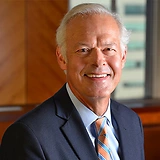Bruce Petrie Jr. is a partner at Graydon Head and author of a new book, "Constitutional Conversation: A New Lens on America's Best Masterpiece."
Looking for some inspiration during a dispiriting political season? Try the Constitution. In its third century of endurance, artfully concise at about 8,000 words, inspired by the revolutionary idea that ordinary people rather than kings would be sovereigns of our civic destiny, there is no greater American civic masterpiece than the Constitution.
Our Constitution's design shares the five qualities of all enduring creative masterpieces in the humanities or science:
- Inspiration. Its inspiration is popular sovereignty in service of "a more perfect union," justice, domestic tranquility, the common defense, the general welfare and "the blessings of liberty to ourselves and our posterity."
- Composition. The word "constitution" means composition: a unity of seven Articles and 27 Amendments that is greater than its parts. It's a whole work, not a fragmentation of special interests.
- Balance. It balances power through tripartite branches, bicameralism, federalism, voting, individual and communal rights, all circling back to the people as sovereign.
- Emphasis. Its narrator is emphasized in the first three large-font words that Jacob Shallus, its original calligrapher, inscribed "We the People."
- Craftsmanship. Its craftsmanship, including its expectation of amendment (Article V) and interpretation, has helped it last longer than any written national constitution on earth.
Does it seem like the Constitution is shrinking? It doesn't shrink unless our lens does, which today too narrowly reduces to two lenses: political or legal. But the Constitution isn't red or blue; it never mentions or guarantees political parties. Nor is the Constitution the exclusive province of lawyers and judges. The Constitution creates the Supreme Court, not the other way around. More than just a political or legal code, our Constitution is cultural in breadth, involving how we live and relate to one another as citizens, and embodying the ideas, ideals and values that will, if anything will, be the glue that holds us civically together.
To say our current politics are not working doesn't mean our Constitution isn't working. When the necessary consensus and cooperation is lacking, the Constitution clicks into "waiting" mode. It operates like the main power circuit box in the republic's house, throwing a breaker on the power flow when branches aren't working together. Better to check and balance power than to let it keep flowing into autocratic use. For example, a circuit breaker is thrown on the appointment of a ninth Supreme Court justice. The Constitution requires the president to appoint with the advice and consent of the Senate; neither branch gets to unilaterally seat a new Supreme Court justice. The Constitution doesn't run ahead of the people but patiently sits in "wait mode" while we witness how judicial power is checked when there are eight rather than nine justices.
Our cultural Constitution entrusts the republic to the best civic selves of We the People, or else why base a government on popular sovereignty? Its text refers to voting no fewer than five times and embodies the fight by American women and others originally excluded from voting. Our most important free-speech right can do better than our low voter turnout rates. If we look through a broader lens, we can see our best civic selves all around. Last Sunday, it was in the memory of Sept. 11, 2001, in the solidarity of ordinary citizens and responders. We can see it in the everday, local acts of citizenship, volunteerism and community support. I saw it this morning in our neighborhood as I watched again the retiree, volunteer crosswalk guard shepherding a group of first graders across a busy street to their public school.
The Constitution has always been an ongoing conversation. Your participation in thoughtful conversation matters. It reaffirms the larger faith in We the People that needs to pass, if at all, from generation to generation.

